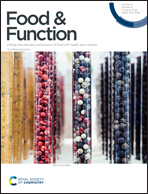Neuroprotective effect of thiamine-producing lactic acid bacteria in a murine Parkinsonian model
Abstract
Parkinson's disease (PD) is a progressive neurodegenerative disorder characterized by deterioration and loss of dopaminergic neurons in the substantia nigra pars compacta (SNpc), resulting in motor deficits. Many studies have revealed an inverse relationship between thiamine consumption and susceptibility to PD. Previously, Lactiplantibacillus (L.) plantarum CRL 1905 was selected as thiamine-producing lactic acid bacteria (LAB), and its amprolium-resistant clone, L. plantarum CRL 1905*, was able to produce higher levels of this vitamin and inhibited neuronal death in an in vitro model. The present work aimed to evaluate the neuroprotective effect of these thiamine-producing LAB in an in vivo parkinsonian mouse model. Male C57BL/6 mice injected with 1-methyl-4-phenyl-1,2,3,6-tetrahydropyridine (MPTP) were orally administered with one of the LAB strains or commercial thiamine for 1 month. The administration of either thiamine-producing LAB prevented the motor deficits of mice similar to the effects of the commercial vitamin. These benefits were associated with increased number of tyrosine hydroxylase positive (TH+) neurons in the SNpc. The evaluation of the inflammatory response caused by the neurotoxin showed that both LAB decreased pro-inflammatory cytokines in serum; moreover, the strain selected as the higher thiamine producer showed the best anti-inflammatory effect locally in the brain and significantly decreased the levels of IL-6, TNF-α, IFN-γ and MCP-1, which remained similar to the levels of healthy control animals. These results demonstrated that thiamine-producing L. plantatum CRL 1905* has the potential to be used as part of a strategy to prevent or to complement the treatments of neurodegenerative diseases such as PD. A limitation of this study is that we cannot guarantee whether LAB are capable of producing thiamine in the intestinal tract or release the vitamin after lysis; however, the results show that thiamine production by L. plantarum CRL 1905 is implicated in the observed effect, in addition to other benefits associated with the LAB strain that are also involved and are currently under study.



 Please wait while we load your content...
Please wait while we load your content...